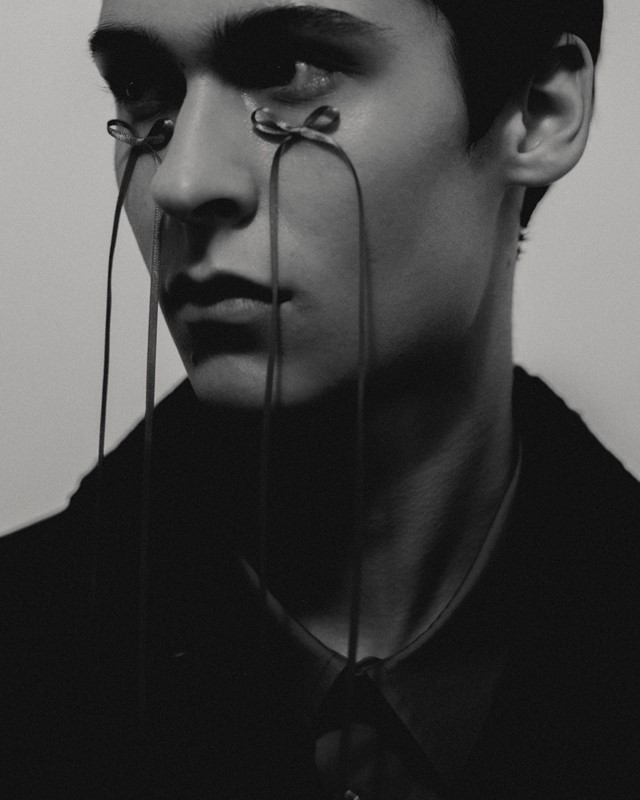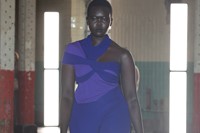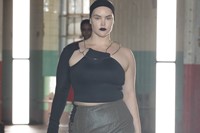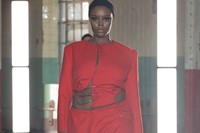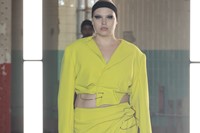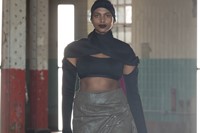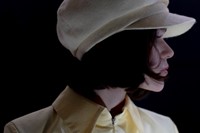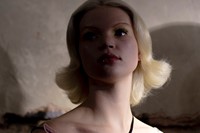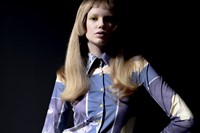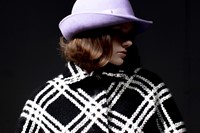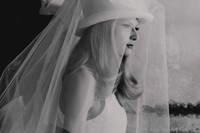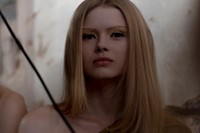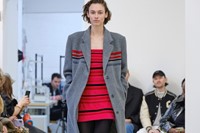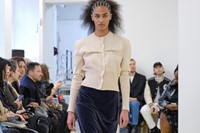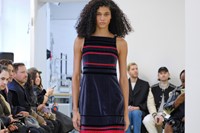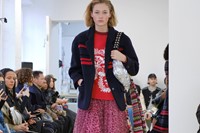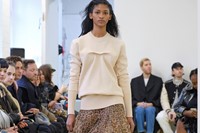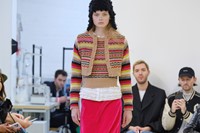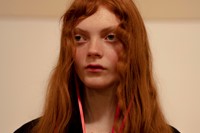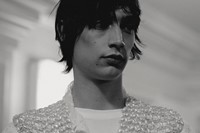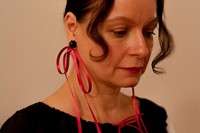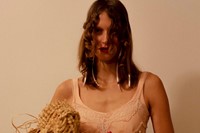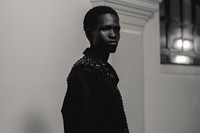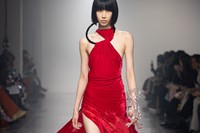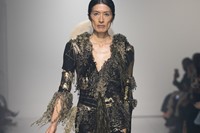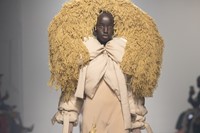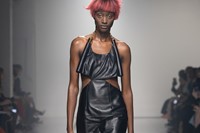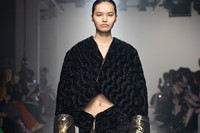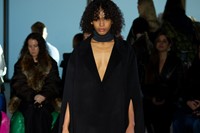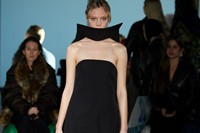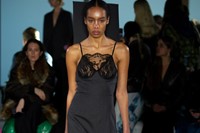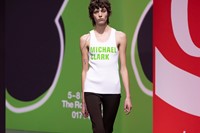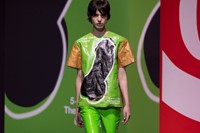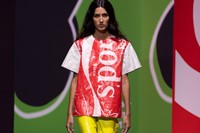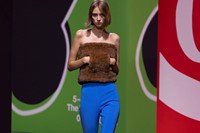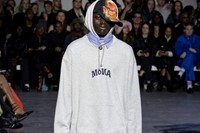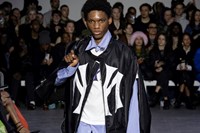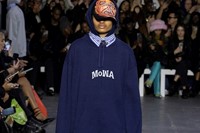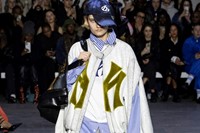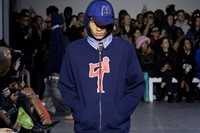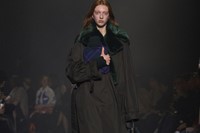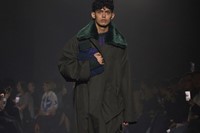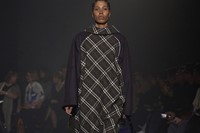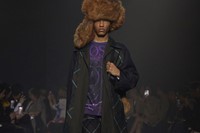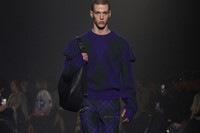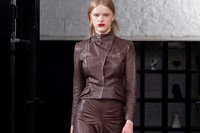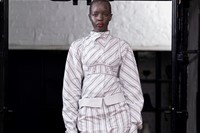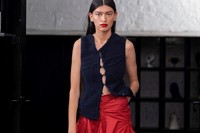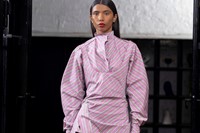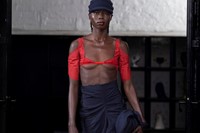From Daniel Lee’s debut Burberry show to JW Anderson’s adoring homage to Michael Clark; these were the best collections from London Fashion Week A/W23
Fashion East
Red carpet, squat party or raucous work drinks – Lulu Kennedy’s Fashion East had it all. Returning for his second season, Michael Stewart’s Standing Ground led the proceedings, enhancing its calling cards – trailing ball gowns and eveningwear – with swaddling trains and couturier touches including make-believe hips, contoured knotting and pinched duchesse shoulders. Next in line, fellow sophomore Johanna Parv took her collection on a techier turn, serving rave-ready numbers in safety orange, sweat-wicking greys and quick-action buckles that models deployed in real time. Alongside these, a toggled balaclava, complete with a gap for ponytails, and Nike cycling shoes felt reminiscent of a young Craig Green, only sexier. “I want my women to look powerful. Maybe even a bit daunting,” said Parv. Mission accomplished. Finally, Karoline Vitto closed the tripartite with a Y2K-meets-80s-gold symposium of partywear and NSFW office-core, each fastened with chrome bangles and back-off shoulders.
Conner Ives
Conner Ives mined the late noughts for yesteryear’s crimes against fashion: flared jeans below frilly dresses, vaguely Mediterranean sarongs and westernised spins on cheongsam dresses. Somehow, he made these chic. Between chain belts designed using seaside-town crystals and illustrated boots, his irony operated on two levels, appropriating the appropriated in a postmodern blend that revived charity-shop tat and late-capitalist detritus with impeccable patchworking, in a 70s palette and 80s cuts. Tack is back. That, or we’ve been had by Ives once again.
Read AnOther’s interview with Conner Ives here.
Molly Goddard
Fashion pundits touting the return of reduction might cite Molly Goddard as proof. Harking back to her halcyon days at Central Saint Martins and hours spent idling in her local shopping centre as a teen, Goddard presented clothes for wearing and finding oneself in, not flexing. This was Goddard before fashion’s glamorous demands, rendered in nods to Ralph Lauren editorials and teen experimentation. Think prep-school stripes, studded Mary Janes reminiscent of rock-chick belts and just a blush of tulle. The result, Goddard said, “is a collection that feels nostalgic, familiar, grown up, wearable, streamlined.”
Simone Rocha
Even the coolest frowers were reduced to tears at Simone Rocha’s latest foray into folklore. Taking cues from Lughnasadh, the traditional Irish festival, the Dublin-born designer soundtracked her show to the dulcet tones of folk band Lankum, serving up a harvest of raffia-filled puffball skirts and tangled macramé bags. Alongside her signatures – pearlescent ovule bags, bijou slippers and lingerie lace – came effete, jewelled sailor collars and pleated leather skorts for her recent Rocha man. Queerbaiting softbois, take heed.
Read AnOther’s feature on the Simone Rocha show here.
Asai
After a four-year hiatus from the runway, south London’s darling designer A Sai Ta is back with a bang, dredging up an uncanny slew of sprites and faeries for his latest fever dream. “So many times throughout the week I actually felt like I was dreaming,” he recalls, post show. “It’s been really exciting, really surreal.” With a slowed-up rendition of Show Me Love wining in the background, models stormed the runway in threadbare denim bodycons and earthy textiles that clung from the body like moss. Elsewhere, a few nunchuck accessories and his iconic tie-dye were thrown in, resulting in a tripped-out medley of decadence.
Christopher Kane
Falling somewhere between kinky and grotesque, Christopher Kane’s anatomical offering doubled down on off-kilter cuts and clinical adornments, finishing dresses with paillette inside-out muscle contours and spine-chilling neck braces. Flattering, this was not. But that’s the point. Kane treads a fine line between horror and sensuality, training the eye towards our bodies’ grisliest, boniest sections, somehow making them elegant. Of course, his USPs – rubber and latex – remained pivotal, anchoring the collection with undulating, lubed-up ruffles perfect for a red-carpet dominatrix.
JW Anderson
Just as Covid put the country in cultural gridlock, choreographer Michael Clark’s first major retrospective opened at the Barbican, presenting an illustrious oeuvre of queered ballet alongside revolutionary artistic collaborations with names like The Fall, BodyMap’s Steve Stewart and David Holah, and nightlife legend Leigh Bowery. Fortunately, for those that missed out, Jonathan Anderson channelled this energy into a bizarro pick of merch, spanning paper-bag effect T-shirts, gargantuan lapels and the Peter Saville-designed cock everyone knows Clark for. “Sometimes I think all roads lead to Michael Clark – for me at least,” said Anderson. “But I imagine also for people in this room. Michael Clark is not only a choreographer of bodies, but of British culture at large.”
Read AnOther’s piece on Michael Clarke’s Barbican exhibition here.
Mowalola
Nothing says “welcome to late capitalism” quite like a show about late capitalism. Entitled Dark Web, Mowalola’s bootlegged bonanza of corporate logos, Yankees insignia and ‘Tor-Core’ goggles painted a dark picture of life amidst monopolies, incels and technology more powerful than its creators. Whether she’s picking up where Demna left off remains to be seen, but her post-internet boleros and hot pants would suggest so, slotting her in a cohort of neoliberal hellscapers like Jon Rafman, Adam Curtis and Demna himself.
Dilara Findikoglu
You can tell a CSM alumn from miles away, and Dilara Findikoglu is no exception. The giveaways? An obsessive knowledge of costume dress, circulation-cutting corsetry and a sharpened vision of who and what they stand for. For Findikoglu’s A/W 23 show, it’s women and strength in global hardship, the latter prescient to her native Turkey. “I decided to do what I do best,” explained Findikoglu. “Use my voice as much as I can.” Indeed, the designer successfully combined déshabillé leotards, McQueen-esque feathers and eyeletted lacing in her bid to reclaim women’s bodies and hope. Brava.
Burberry
The hottest ticket in town, Daniel Lee’s ‘new Burberry’ summoned feverish speculation from the moment it was announced. Many industry insiders hoped the Yorkshireman would lean into its British heritage, providing a new vision while reinstating codes lost under Tisci’s reign. Fortunately, Lee came good, going all out with the once-demonised check in a spectrum of new hues, spanning canary yellow and purple, Scotsman red with white, and cool, royal blues. Ticking off the rustic charm of Old Blighty’s highlands and the ebullience of its subcultural tribes, the collection was a blend of nobility and transgression, scored to the wailing breakbeats of south London’s grittiest producer, Burial. Providing every guest with a hot water bottle, this first outing made a romantic ode to the hearty, grin-and-bear-it resilience that crosses UK’s class lines, whatever the weather.
Talia Byre
Talia Byre’s second ever runway show honed in on independent women who like to do things their own way – particularly, the bolshy leading ladies in films like The Graduate and Funny Girl. Shown on Sunday evening amid flickering candlelight in Borough’s intimate Lant Street Wine venue for a small audience of friends, family and press, models strutted across rickety floorboards in form-fitting ensembles made up in deliciously rich, earthy colours (the collection’s colour palette paid homage to Helen Frankenthaler’s 1957 abstract painting Jacob’s Ladder). Dangerously thin bralettes, brightly coloured tights, copious amounts of leather and one washed-out leopard print full wool and cashmere look pointed to the quiet confidence and sensuality of Byre’s designs – here, you got the sense women are dressing for other women, not for men. Byre’s self-assured, feminine aesthetic and luscious use of colour – along with sharp tailoring and masterful drapery – make her one of London’s most exciting young womenswear designers to watch.
